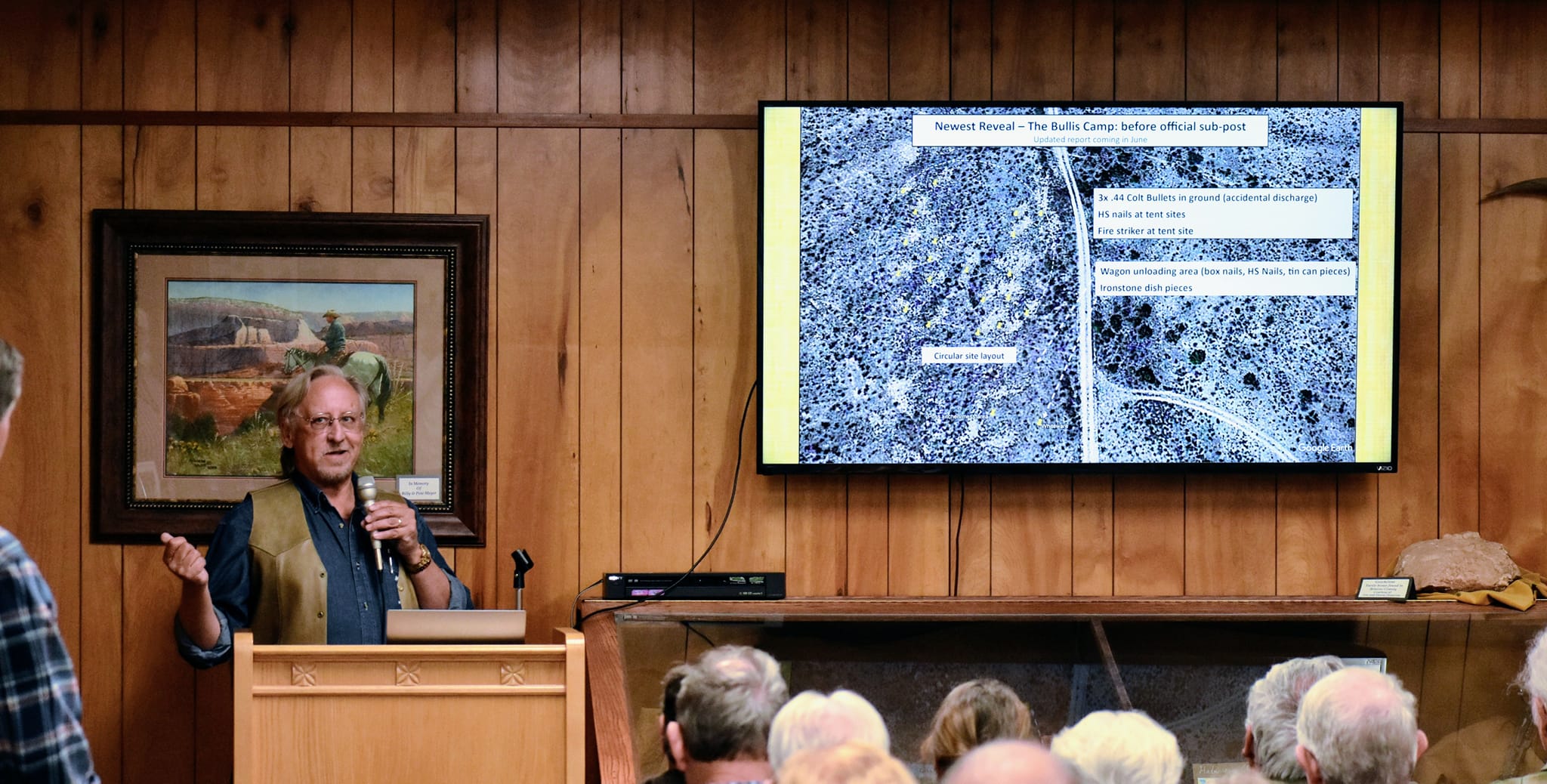Dozens turn out for Comanchero Canyons Symposium April 22
Article by Marisue Potts published in the Caprock Courier, April 27th, 2023.
QUITAQUE —A group of about 60 people interested in archeology and history attended the Southwestern Federation of Archeological Societies annual meeting April 22, 2023, at the Comanchero Canyons Museum (CCM) in Quitaque. Special guests with ties to Comanchero trader Jose Piedad Tafoya were Louis and Holly Gallegos, Clarese Romero, and Michael Chavira of the San Miguel Land Grant, New Mexico. They are interested in sharing information across the two cultures and state boundary lines. CCM president Jerry Leatherman welcomed guests and gave a brief description of the Santa Fe Expedition of 1841, which was stalled at the edge of the caprock near Quitaque. A cache of brass rings, excavated near one of several camps, is on display in the museum, along with maps and other documentation concerning the Texans' capture, their long, forced walk from Santa Fe to Mexico City, and their imprisonment for being invaders to New Mexico.

Archaeologist Brett Cruse

Archaeologist Brett Cruse
CRUSE ON CORONADO ROUTE. Headlining the six speakers of the day, Brett Cruse, chief archeologist with the Historic Sites Division of the Texas Historical Commission, presented "Distributions of Proto Historic Sites on the Texas Southern Plains and Implications for Coronado's 1541 Route." This paper provided a convincing argument for location of the two barrancas (large can-yons) encountered by the Coronado Expedition of 1541 by studying the concentration of camp sites of the Querechos and the Teyas, indigenous tribes encountered and documented by the expedition's scribe Castanedo. Tracing geographical features and applying clues from the descrip-tions and campsites, Cruse posits that Yellowhouse Canyon was the first barranca reached and Blanco Canyon, the second, thus overturning previous theories of many historians. His much-anticipated paper with many illustrations is due to be printed through another organization. Cruse's much acclaimed book "The Battles of the Red River War" is available at the Quitaque museum.
CEPEDA DISCUSSES LONG EXPEDITION. "The Natural History of the 1820 Stephen Long Expedition" was presented by Joseph Cepeda, retired geology professor from West Texas A&M University. The U.S. government had an interest in establishing the Red River boundary and sent the group out to collect information about the river, although they mistakenly followed the Canadian River instead. Botanist Edwin James documented many previously unknown species of plants and animals on the trek, as given by Cepeda. The hardships the expedition experienced made James describe the area as the "Great American Desert," unfit for habitation, a barbaric land that led to barbaric people, the Kiowa-Apaches he encountered.

Archaeologist Tom Ashmore

Archaeologist Tom Ashmore
ASHMORE TRACKS TRAILS. Spending 22 years in the Air Force as a special intelligence analyst gave Tom Ashmore a real heads-up on tracing and identifying trails, stage stations, and military camps by using satellite imagery. He has recently established the West Texas Archeology Society, enrolling members and posting reports and videos on the internet. As an avocational archeologist who has worked with the Texas Archeological Society for 15 years, Ashmore collaborated on three papers with C.A. Maedgen, who has served as Region 10 director for Texas Archeological Society, as Concho Valley president, and as a board member of the Southwest Federation Archeological Society. Ashmore, author of "The Butterfield Trail Through Concho Valley and West Texas," lifted the veil off of the little known or recognized Butterfield Overland Mail's Antelope Spring Station because it was off what had been considered the trail. The author used military records to prove his overhead identifications of the trail and distances were correct. "Camp Meyers Spring and the Black Seminole Scouts" offered Ashmore a chance to use his military experience in identifying number of troops from camp layouts, including the U.S. military isolation from the Seminole Scouts, an award-winning black troop which received several Medal of Honor awards for their performance and bravery. C.A. Maedgen collaborated with Ashmore on "Camp Meyers Spring Conquistador Pictograph" and documented their interpretation of just one of the many pictographs on a bluff wall that unfolded like a story book. The conquistador's weapon was identified as a weapon the Espejo Expedition was carrying, along with a shield, and just below the figure was the outline of a horse, perhaps the first seen by the indigenous tribes.

Crowd at SWFAS

Crowd at SWFAS
DAY ON AREA SITE OF BUFFALO HUNTERS' STORE. Canyonlands Archeology Society president and founder Rick Day has a geology degree and has been a teacher of natural science courses for 34 years. He has served as an archeological steward for THC and Region 2 Director for the Texas Archeology Society. At one point Day organized his 7th and 8th grade school students into excavators of an historic Indian site as a weekend field trip. Through Duane Johnson of Foard County Museum, Day was consulted about a possible buffalo freighting trail that went by Good Creek that could pinpoint "A Possible Location of Good Creek Buffalo Hunters' Store." With slides of trails, rock accumulations, and grids, as well as descriptions and location of artifacts, Day believes this is likely the location which could be proven by further excavation.
CROWNOVER ON ADVICE TO ENTHUSIASTS AND LANDOWNERS. Finishing the day of talks was Jim Crownover, member of West Texas Historical Assoc., a founding member of West Texas Trails, and Canyonlands A.S. Crownover, who retired from the Natural Resources Conservation Service, gave a wonderful summary of the most productive way to assist landowners who have an interest in identifying archeological sites, be considerate, helpful, friendly, and treat them with the highest respect. Crownover gave as an example his work on locating Gholson Spring through aerial photographs and identification of trails. He provided a fitting end to a wonderful session. Like old friends, the attendees had much to discuss as they toured the Comanchero Canyons Museum.

